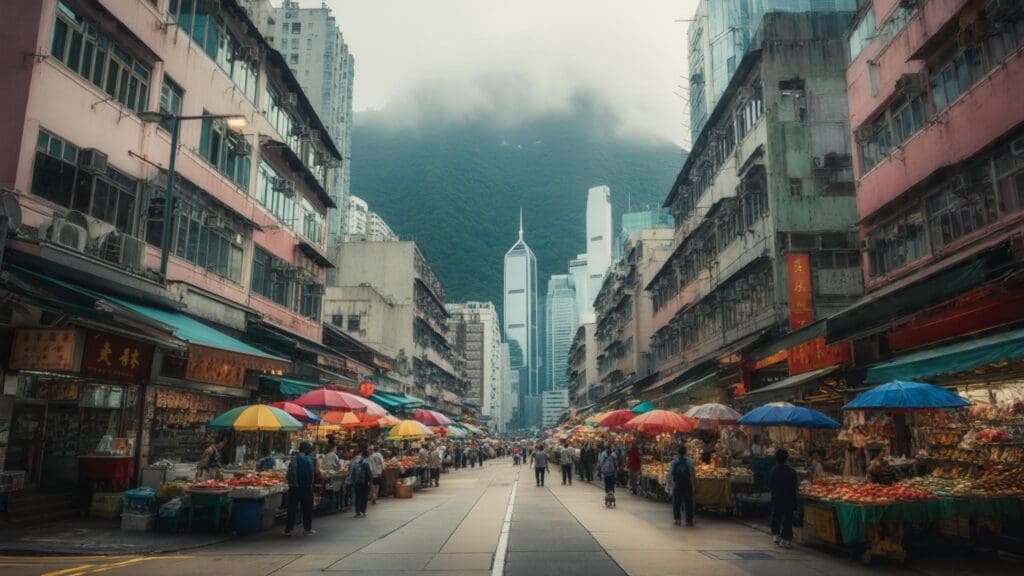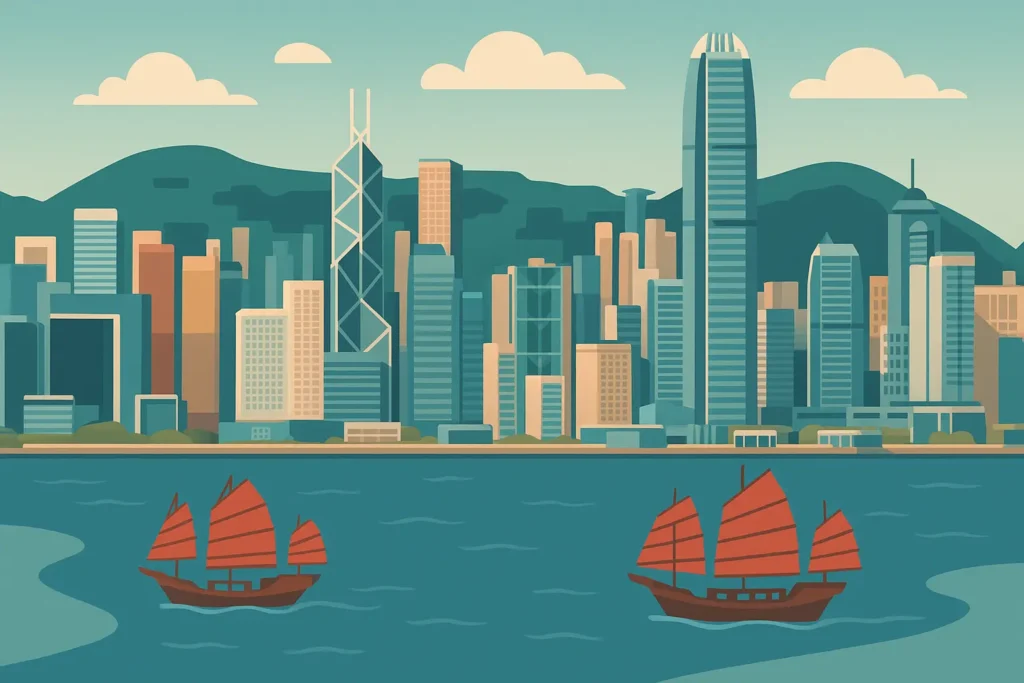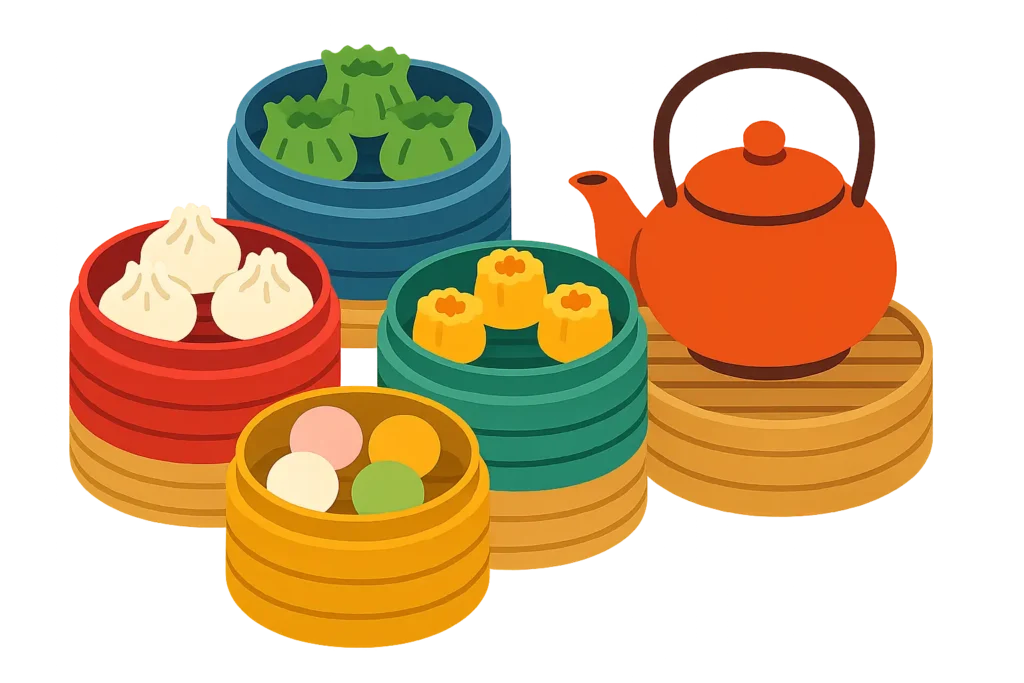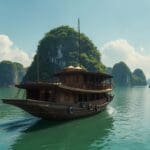Hong Kong receives over 55 million visitors annually, making it one of the world’s most popular travel destinations. I remember staring at that statistic while planning my first Hong Kong trip, feeling completely overwhelmed by the endless possibilities. With just three days and zero local knowledge, I needed a foolproof plan that wouldn’t leave me wandering aimlessly through crowded streets. That’s when I discovered the power of having multiple itinerary options tailored to different travel styles, budgets, and interests.
Quick Resources:
-
Plan your personalized Hong Kong adventure with our Vacation Planner
-
Explore all our travel and event tools at All Wedding Tools
Look, I’ve been to Hong Kong more times than I can count, and I’ve made pretty much every mistake in the book. So I put together 25 different ways to explore the city – some I’ve tried myself, others I wish I had known about during my first chaotic visit. Whether you’re a first-timer with limited time, a foodie seeking authentic flavors, or a budget backpacker maximizing every dollar, there’s a perfect Hong Kong itinerary waiting for you.
Start crafting your perfect trip with our Vacation Planner
TL;DR
- Most visitors find 3 days optimal for experiencing Hong Kong’s highlights, though 4-6 days allows deeper exploration
- Spring (March-May) and fall (September-November) offer the most comfortable weather for outdoor activities
- Budget options range from under $50 USD daily for backpackers to $300+ for luxury experiences
- The Octopus Card is essential for seamless transportation across all itinerary types
- Choose accommodation location based on priorities: Central for business, Tsim Sha Tsui for attractions, Causeway Bay for shopping
- Match your physical capabilities with appropriate activities – some itineraries involve significant walking or hiking
- Solo travelers have maximum flexibility while families need child-friendly activities and couples prefer romantic experiences
Key Considerations for Planning Your Hong Kong Trip
Before diving into specific itineraries, you need to figure out what kind of traveler you actually are. Trust me, I learned this the hard way after my first chaotic Hong Kong trip where I tried to do everything and ended up enjoying nothing. Duration and timing affect everything from accommodation costs to whether you’ll be melting in humidity or shivering on the Star Ferry. Budget considerations influence whether you’re eating amazing street food or overpriced tourist trap meals, while personal interests and physical capabilities determine if you’ll be hiking Dragon’s Back or hiding in air-conditioned malls.
Duration and Timing Strategy
Here’s the real talk about trip length: most people think they need a week in Hong Kong, but honestly, 3 days hits the sweet spot for experiencing major highlights without feeling like you’re checking boxes on a list. You’ll have enough time to see Victoria Peak, explore traditional markets, and catch the Symphony of Lights show without that rushed tourist panic.
My first Hong Kong trip? Total disaster. I spent half my time lost in Central Station (seriously, that place is like a maze), ate at tourist trap restaurants that cost twice as much as the amazing hole-in-the-wall places I discovered later, and somehow managed to miss the Symphony of Lights show three nights in a row because I kept getting distracted by street food.
However, 4-6 days opens up possibilities for actually understanding the city instead of just photographing it. Extended stays let you experience Hong Kong’s rhythm beyond tourist attractions – morning tai chi sessions in parks, late-night street food adventures, and those spontaneous discoveries when you take a wrong turn and find an incredible local market.
Can we talk about the weather for a second? The travel guides don’t prepare you for stepping outside in summer and immediately feeling like you’re breathing through a wet towel. That ‘mild winter weather’ sounds nice until you realize 60°F feels freezing when you’ve been living in tropical heat. I packed all summer clothes for my December trip and spent my first day buying a jacket because I was shivering on the Star Ferry.
| Season | Temperature Range | Reality Check | Crowd Levels | Cost Impact |
|---|---|---|---|---|
| Spring (Mar-May) | 65-80°F | Perfect for everything, but everyone knows it | Moderate | Standard rates |
| Summer (Jun-Aug) | 80-90°F | Humid as a sauna, pack extra shirts | High | Peak season rates |
| Fall (Sep-Nov) | 70-85°F | Sweet spot for weather and activities | Moderate | Standard rates |
| Winter (Dec-Feb) | 60-70°F | Cooler than you think, bring layers | Low | Best deals available |
Budget and Accommodation Decisions
Your accommodation location shapes your entire Hong Kong trip, and I’ve stayed everywhere from luxury harbor view suites to hostels where the bathroom was shared with twelve people. Central and Admiralty put you in the heart of everything with easy access to major attractions, but you’ll pay premium prices. The upside? You can walk to most places and save on transportation.
Tsim Sha Tsui offers that classic tourist experience with harbor views and proximity to shopping, but it’s also where every tour group ends up. Causeway Bay is where I actually recommend staying – it provides excellent value for shoppers and food enthusiasts, with countless restaurants and local markets within walking distance, plus you’ll feel more like a local and less like a walking wallet.
Don’t even get me started on transportation budgets. Airport Express costs around $12 USD but saves you from figuring out the regular train system when you’re jet-lagged and cranky. MTR day passes are the best deal at about $5 USD daily – unlimited travel and you’ll use it more than you think. Taxis seem convenient until you’re stuck in traffic watching the meter climb while your dim sum reservation slips away.
Real Budget Reality Check – My Friend Sarah’s Trip: Sarah chose a boutique hotel in Causeway Bay ($120/night) instead of a fancy Central hotel ($200/night), saving $320 total. She used that money for a helicopter tour ($180) and still came under budget. But here’s what nobody tells you – her strategic location choice put her within walking distance of Times Square shopping and authentic local restaurants, while MTR access kept transportation costs under $25 for the entire trip. Smart move.
Use our Vacation Planner to match your trip style with the perfect budget
Personal Interests and Physical Capabilities
Look, be honest with yourself about what you actually enjoy. Cultural enthusiasts will love temple visits and museum explorations, but if you get bored after 20 minutes in museums, don’t plan a culture-heavy Hong Kong travel itinerary. Adventure seekers will thrive on hiking trails and island hopping, but if you’re not in decent shape, Dragon’s Back Trail will humble you quickly.
Pro tip I learned the hard way: Don’t try to do Victoria Peak and Ocean Park in the same day. I was basically a zombie by dinner time and missed out on the night markets because I could barely stand. Some itineraries involve significant walking, steep climbs, or extended standing periods, and Victoria Peak’s tram alternative requires moderate hiking fitness that I definitely didn’t have during my first visit.
Consider your energy patterns too. Are you someone who jumps out of bed at sunrise ready to conquer the world, or do you need three cups of coffee before becoming human? Hong Kong accommodates both with 24-hour dining options and early-opening attractions, but plan accordingly.
Group Dynamics and Special Considerations
Solo travelers have it easy in Hong Kong – maximum flexibility means you can change plans when you discover that amazing street art district or spend three hours in a temple because it speaks to you. Safety concerns are minimal in Hong Kong’s well-lit, populated tourist areas, though the biggest danger is probably eating too much street food and feeling sick on the MTR.
Make solo travel smoother with our custom Vacation Planner
Families need to be realistic about kids’ attention spans and energy levels. Hong Kong Disneyland and Ocean Park are obvious choices, but don’t underestimate how much kids will love the Star Ferry or feeding fish at Nan Lian Garden. Just accept that you’ll move slower and need more bathroom breaks than your pre-kid travel days.
Couples often want those Instagram-perfect romantic moments – sunset harbor cruises, intimate rooftop dining, and scenic cable car rides. Hong Kong delivers on all fronts, but book ahead because everyone else wants the window table too. Business travelers need to be ruthlessly efficient with limited free time, which means early morning temple visits before meetings and evening harbor views that can double as client entertainment.
Duration-Based Itineraries
Here’s how to plan based on how much time you actually have, from quick layover adventures to extended cultural deep-dives. These aren’t rigid schedules – they’re flexible frameworks that I wish someone had given me during my first overwhelming visit to Hong Kong.
1. Classic 3-Day Hong Kong First-Timer
This 3 day Hong Kong itinerary covers the essentials without that frantic tourist checklist feeling. Day one focuses on those iconic views everyone expects – Victoria Peak’s panoramic skyline (go early to avoid crowds) and the Star Ferry’s historic harbor crossing that costs basically nothing but feels priceless.
Day two introduces cultural elements through Man Mo Temple’s incense-filled halls that smell like ancient prayers and traditional markets where you’ll probably get lost but discover amazing things. You’ll experience authentic dim sum (try not to fill up on the first cart), explore antique shops on Hollywood Road where bargaining is expected, and catch the Symphony of Lights show from Tsim Sha Tsui Promenade.
Day three offers theme park magic at either Ocean Park or Hong Kong Disneyland, followed by Temple Street Night Market’s chaotic energy. This combination provides family-friendly entertainment and authentic street food experiences, though prepare for sensory overload.
The classic first-timer itinerary balances those must-see Instagram moments with real cultural experiences. It includes major highlights while incorporating authentic local experiences through markets and street food adventures that’ll give you stories to tell back home.
2. Extended 3-Day Cultural Immersion
If you want to actually understand Hong Kong instead of just photographing it, cultural immersion goes way beyond surface-level tourist attractions. Day one explores Wong Tai Sin Temple’s colorful architecture where people actually pray for good fortune, and Chi Lin Nunnery’s serene Buddhist atmosphere that provides peaceful contrast to the city’s intensity.
Day two dives into Hong Kong’s complex history through specialized museums and heritage sites. You’ll participate in traditional tea ceremonies (it’s more complicated than you think), learn about local customs, and interact with residents in authentic settings instead of just buying souvenirs from them.
Day three combines traditional markets with culinary education. Dim sum crawls introduce you to flavors you can’t pronounce but will never forget, while Cantonese opera performances showcase traditional arts that most tourists skip entirely.
This 3 days in Hong Kong approach appeals to travelers who want stories and understanding, not just photos. The cultural immersion itinerary prioritizes authentic local experiences over tourist attractions, featuring traditional temples, specialized museums, and hands-on cultural activities for travelers who want to understand Hong Kong’s soul.
3. Foodie’s 3-Day Adventure
Hong Kong’s food scene deserves its own vacation, honestly. Day one covers Central’s diverse food halls where office workers eat (always follow the locals), rooftop dining with harbor views that justify the splurge, and guided street food tours that keep you safe while introducing incredible flavors.
Day two combines traditional dim sum breakfasts with hands-on cooking classes where you’ll learn why your homemade dumplings never look right. Evening night market visits provide street food adventures that’ll test your spice tolerance and expand your definition of delicious.
Day three elevates everything with Michelin-starred dining (Tim Ho Wan has a Michelin star and costs like $20, though you’ll wait two hours), local brewery tastings, and dessert crawls through different neighborhoods. This progression from street food to fine dining showcases Hong Kong’s complete culinary spectrum during your 3 days in Hong Kong.
The foodie adventure itinerary transforms Hong Kong into your personal culinary playground, progressing from street food tours to Michelin-starred experiences while including hands-on cooking classes and traditional tea ceremonies that’ll make you a more interesting dinner party guest forever.
4. Family-Friendly 3-Day Fun
Family itineraries need to balance kid entertainment with parent sanity. Day one dedicates full attention to Hong Kong Disneyland, allowing children to experience Disney magic while parents enjoy surprisingly well-designed attractions and shows that don’t make you want to hide in the bathroom.
Day two combines Ocean Park’s thrills with Aberdeen fishing village’s cultural elements. Kids learn about marine life while parents appreciate traditional boat tours and seafood restaurants where the fish was swimming an hour ago. Everyone wins, though someone will probably get seasick.
Day three focuses on interactive learning through Science Museum hands-on exhibits that actually work and Space Museum planetarium shows that won’t put kids to sleep. Avenue of Stars provides harbor views and photo opportunities that appeal to all ages during your 3 days in Hong Kong experience.
The family-friendly itinerary combines entertainment with education, featuring theme parks and interactive museums that engage children while providing meaningful experiences for parents who want more than just sugar-rushed kids and empty wallets.
Interest-Based Itineraries
These specialized routes cater to your actual interests instead of generic tourist checklists. Whether you’re hunting for shopping bargains, chasing Instagram shots, seeking outdoor adventures, or exploring architectural marvels, there’s a Hong Kong itinerary that speaks your language.
5. Shopping Enthusiast’s Dream
Hong Kong’s shopping reputation spans from luxury malls where you can buy things you can’t pronounce to bargain markets where negotiation is performance art. IFC Mall and Harbour City showcase international brands with tax-free advantages, but honestly, you can get most of this stuff at home.
The real magic happens at Ladies’ Market and Temple Street where you’ll negotiate for things you didn’t know you needed and probably don’t. Factory outlets in Tsim Sha Tsui provide designer goods at reduced prices, though ‘reduced’ is relative when you’re talking about luxury brands.
Here’s what nobody tells you: local shopping guides reveal hidden gems where residents actually shop, avoiding tourist markup prices that’ll make your credit card cry. Weekday mornings offer less crowded luxury malls, while evening markets come alive with energy and better bargaining opportunities because vendors want to go home.
The shopping enthusiast Hong Kong itinerary maximizes retail opportunities from luxury tax-free malls to authentic local markets, including insider tips on bargaining (start at 30% of asking price) and seasonal sales timing while balancing high-end shopping with unique local finds that actually have stories.
6. Photography & Instagram Perfect
Hong Kong offers countless photogenic locations beyond those basic tourist shots everyone takes. Sky Terrace 428 provides panoramic city views that look like screensavers, while Choi Hung Estate’s rainbow buildings create vibrant backdrops for social media content.
But here’s what nobody mentions: those Instagram-perfect rainbow apartments? They’re literally someone’s home. Be respectful, don’t block doorways for photos, and maybe don’t show up at 6 AM when people are trying to get to work.
Montane Mansion’s cylindrical architecture gained fame through Transformers movies, and PMQ design district offers street art and creative installations perfect for unique photography angles that don’t scream ‘tourist.’
Golden hour timing transforms ordinary locations into extraordinary shots, but you’ll be competing with every other photographer in Hong Kong. Sunrise at Dragon’s Back Trail captures coastal beauty if you can drag yourself out of bed, while sunset from Victoria Peak showcases the city’s glittering skyline alongside fifty other photographers.
The photography itinerary targets Hong Kong’s most Instagram-worthy locations, including famous movie filming sites and colorful residential buildings, providing specific timing recommendations while revealing lesser-known photogenic spots that won’t have crowds of tourists ruining your shots.
7. Adventure & Nature Lover
Hong Kong surprises visitors with extensive hiking trails and pristine beaches that make you forget you’re in one of the world’s densest cities. Dragon’s Back Trail offers moderate difficulty with spectacular coastal views, consistently ranking among Asia’s best urban hikes, though ‘moderate’ might be subjective depending on your fitness level.
About that Dragon’s Back Trail everyone raves about – it’s gorgeous, but it’s also completely exposed to the sun. I went at noon in July and nearly passed out. Learn from my mistake: go early or go home.
Lantau Island provides diverse outdoor experiences from Big Buddha cultural sites to secluded beaches perfect for swimming and pretending you’re somewhere tropical. Sai Kung’s beaches rival actual tropical destinations with clear water and dramatic rock formations that’ll make your friends jealous. Adventure activities include rock climbing, sea kayaking, and island hopping via traditional junks that smell like fish but provide authentic experiences you can’t get from tour boats. These experiences showcase Hong Kong’s natural beauty beyond its urban reputation, though you’ll need decent fitness levels and realistic expectations about weather conditions.
The adventure itinerary reveals Hong Kong’s surprising natural side through hiking trails and pristine beaches while providing practical information about equipment needs and transportation to remote locations that tourist maps don’t always show clearly.
8. Architecture & Design Explorer
Hong Kong’s architecture tells stories of cultural fusion and rapid development that’ll fascinate anyone who appreciates good design. IFC Tower represents modern engineering achievements that make you wonder how they built something so tall without it falling over, while Heritage buildings in Central preserve colonial history that survived despite developers’ best efforts.
PMQ design district transforms former police quarters into creative spaces showcasing local designers and artists who actually live and work here instead of just selling tourist trinkets. Traditional temples demonstrate classical Chinese architecture principles adapted to urban constraints in ways that somehow work perfectly.
Guided architecture tours reveal construction techniques, historical significance, and future development plans, though be prepared for technical details that might overwhelm casual visitors. Photography opportunities highlight both grand structures and intricate details that most people walk past without noticing.
The architecture exploration itinerary examines Hong Kong’s built environment from colonial heritage buildings to cutting-edge skyscrapers, including design districts and guided tours that explain why buildings look the way they do and how they manage not to fall down.
9. Nightlife & Entertainment
Hong Kong’s nightlife extends far beyond typical bar scenes where tourists get overcharged for watered-down drinks. Lan Kwai Fong offers international atmosphere with diverse bars and clubs, though it can feel like a theme park version of nightlife depending on your tolerance for crowds and inflated prices.
SoHo district provides sophisticated cocktail lounges and wine bars where you can have actual conversations without shouting over terrible music. Rooftop bars showcase stunning harbor views with premium drinks and upscale atmospheres, assuming you can get past the door policies and dress codes.
Night markets combine entertainment with cultural experiences, featuring street food, fortune telling, and local performances that provide alternatives to expensive drinking establishments. Live music venues, comedy clubs, and cultural performances offer options for people who want entertainment beyond getting drunk and taking selfies.
Late-night dining options ensure you can fuel adventures until dawn, because Hong Kong never really sleeps and neither should you if you want the full experience.
The nightlife itinerary explores Hong Kong’s after-dark entertainment beyond typical tourist bars, including sophisticated rooftop lounges and cultural night markets while providing practical information about transportation and safety for when things get interesting.
Budget-Conscious Itineraries
Let’s be real about what different budget levels actually get you in Hong Kong, from ultra-budget survival tactics to luxury experiences that might actually be worth the splurge.
10. Budget Backpacker Special
That $45 backpacker budget? Yeah, it’s doable, but you’ll be eating a LOT of fish balls and your feet will hurt from all the walking. No judgment – I’ve been there. Just know what you’re signing up for. Hostel dorms in Central cost around $15 nightly, providing social atmospheres and local tips from fellow travelers who’ve already made the mistakes you’re about to make.
Street food becomes your culinary education and your main source of nutrition – dim sum from pushcarts, fish balls from vendors, and milk tea from local shops cost a fraction of restaurant prices and often taste better. Wet markets offer fresh fruit and snacks for hiking adventures, though you’ll need to get comfortable with organized chaos.
Free attractions include temple visits where you’ll learn things, hiking trails that’ll challenge you, and harbor walks that provide million-dollar views for zero dollars. Many museums offer free admission days (usually Wednesdays), while public libraries provide air-conditioned rest stops with WiFi when the heat becomes unbearable.
The budget backpacker Hong Kong itinerary maximizes experiences while spending under $50 daily through hostel accommodations and street food dining, emphasizing authentic local experiences over tourist amenities that cost three times as much for half the authenticity.
11. Mid-Range Comfort
Mid-range budgets ($75-150 USD daily) unlock comfortable accommodations and diverse dining options without that constant mental math about whether you can afford lunch. Boutique hotels in Causeway Bay provide local neighborhood experiences with international comfort standards and bathrooms you don’t have to share.
Restaurant meals balance street food adventures with air-conditioned comfort where you can sit down and not worry about finding napkins. You can afford occasional taxi rides during extreme weather while primarily using the efficient MTR system that actually works better than taxis anyway.
Paid attractions become accessible without budget anxiety – Ocean Park, cable car rides, and guided tours enhance experiences when you’re not constantly calculating costs per minute of entertainment.
| Budget Level | Daily Cost (USD) | Reality Check |
|---|---|---|
| Backpacker | $45-50 | Your back will hurt from hostel beds, but you’ll have the best stories |
| Mid-Range | $75-150 | Sweet spot – comfortable enough to enjoy, cheap enough not to stress |
| Luxury | $300+ | Go for it if it’s a special trip, but honestly, street food tastes better than some fancy restaurants |
12. Luxury Experience
Luxury Hong Kong experiences ($300+ daily) justify costs through exclusive access and exceptional service, assuming you value those things over authentic local experiences. Five-star hotels provide harbor views and personalized concierge services that anticipate needs you didn’t know you had.
Private helicopter tours showcase Hong Kong from unique perspectives impossible through standard tourism, though you’ll spend more on 15 minutes in the air than most people spend on entire vacations. Michelin-starred restaurants offer world-class cuisine with impeccable service and wine pairings that cost more than some people’s monthly rent.
Personal shopping assistants, private yacht charters, and exclusive cultural experiences create memories worth the investment if you have money to burn and want experiences you literally can’t buy elsewhere.
Premium spending delivers exclusive access, personalized service, and unique perspectives unavailable to budget travelers through private tours and VIP experiences that bypass crowds and waiting in lines.
13. Free Activities Focus
Hong Kong offers surprising numbers of no-cost attractions that provide better experiences than many paid tourist traps. Temple visits provide cultural immersion without admission fees – Wong Tai Sin Temple’s colorful architecture and Man Mo Temple’s incense ceremonies cost nothing but offer profound experiences if you take time to appreciate them.
Hiking trails provide world-class scenery without cable car expenses, though you’ll need good shoes and realistic fitness expectations. Public beaches offer swimming and relaxation with basic facilities that work fine if you’re not expecting resort amenities.
Free museums on specific days, public parks, and harbor walks create full itineraries without spending money on attractions. Street performances and cultural festivals provide entertainment throughout the year if you time visits right.
This approach proves Hong Kong offers substantial experiences without admission costs through temple visits, hiking trails, and cultural festivals, requiring more planning and flexibility but delivering authentic local experiences that money can’t actually buy.
Seasonal & Weather-Based Itineraries
Weather-based itineraries adapt to Hong Kong’s climate challenges that travel guides don’t adequately prepare you for, from summer heat that makes you question life choices to winter temperatures that feel surprisingly cold when you packed for tropical weather.
14. Rainy Day Indoor Adventures
Hong Kong’s monsoon season requires backup plans that don’t suck, focusing on covered attractions that provide cultural value beyond just hiding from rain. Multiple museums – History Museum, Space Museum, and Art Museum – provide educational entertainment with climate-controlled comfort and bathrooms that don’t require coins.
Shopping centers become cultural experiences themselves when you stop thinking of them as consumer temples. IFC Mall connects to MTR stations via covered walkways that let you travel underground like a mole person, while Harbour City offers harbor views from indoor comfort with restaurants and activities that keep you occupied for hours.
Indoor observation decks at Sky100 and ICC Tower provide skyline views regardless of weather, though clouds might limit visibility and make you feel like you’re inside a cloud instead of above it.
The rainy day Hong Kong itinerary ensures experiences continue despite weather challenges through museums and covered markets while maintaining cultural authenticity instead of just hiding in hotel rooms waiting for sunshine.
15. Summer Heat Survival
Summer temperatures and humidity require strategic timing and location choices if you want to survive without melting into a puddle. Early morning activities (6-9 AM) provide comfortable outdoor experiences before heat becomes a physical assault on your body and soul.
Air-conditioned venues become midday refuges and literal lifesavers – museums, malls, and restaurants provide relief during peak heat hours (11 AM – 4 PM) when stepping outside feels like opening an oven door. Evening activities resume after sunset when temperatures drop and harbor breezes provide natural cooling that makes you remember why people live here.
Swimming opportunities at public beaches and hotel pools become essential rather than optional recreational activities. Hydration strategies require constant attention – pack more water than you think you need and drink it before you feel thirsty.
This approach adapts to Hong Kong’s challenging hot season through strategic timing and air-conditioned refuges while maintaining sightseeing goals instead of just surviving until you can go home.
16. Winter Mild Weather Maximizer
Winter’s mild temperatures (60-70°F) create ideal conditions for extended outdoor exploration that make you understand why people rave about Hong Kong weather. Hiking trails become comfortable all-day activities without summer’s heat exhaustion risks that turn pleasant walks into survival challenges.
Walking tours can extend for hours without weather concerns, and harbor walks, market exploration, and outdoor photography sessions benefit from comfortable temperatures and clear skies that provide perfect lighting conditions.
Outdoor dining becomes pleasant rather than endurance tests, and rooftop bars offer comfortable evening experiences with stunning views instead of battles against elements.
Winter weather maximizing takes advantage of Hong Kong’s most comfortable season for outdoor activities and extended walking tours that let you actually enjoy the city instead of just surviving it.
17. Festival Season Special
Hong Kong’s festival calendar creates unique cultural opportunities that justify planning entire trips around specific dates. Chinese New Year transforms the city with decorations, special performances, and traditional celebrations that provide authentic cultural immersion you can’t experience any other time.
Mid-Autumn Festival features lantern displays and mooncake traditions that showcase local culture beyond tourist attractions. Christmas decorations in shopping districts rival international displays with local cultural twists that create unique photo opportunities.
Festival timing affects crowds, prices, and availability in ways that require advance planning but reward visitors with once-yearly cultural experiences worth the extra effort and expense.
Festival season capitalizes on Hong Kong’s cultural celebrations, requiring advance planning due to crowds but providing unique cultural experiences unavailable during regular seasons that create memories worth the logistical challenges.
Transportation-Focused Itineraries
Don’t worry – I’ve got your back on the transportation stuff. These routes optimize movement efficiency while incorporating scenic journey elements that turn getting around into part of the actual experience instead of just necessary evil.
18. MTR Master Route
The MTR is basically Hong Kong’s lifeline, and it’s so efficient it makes other cities look embarrassing. But here’s the thing – during rush hour, you’re going to be packed in like sardines. I once got separated from my friend for three stops because I couldn’t fight my way off the train.
Organizing attractions by subway lines minimizes travel time while maximizing sightseeing opportunities and reducing that constant “how do we get there” stress. Central Station connects to multiple attractions within walking distance – IFC Mall, Star Ferry, and Victoria Peak tram – while Tsim Sha Tsui Station provides access to museums, shopping, and harbor walks.
MTR day passes offer unlimited travel value that pays for itself after three rides, while station maps help identify attraction clusters that let you see multiple things without constant underground navigation.
The MTR master route maximizes subway system efficiency by organizing attractions around station clusters, minimizing walking distances and travel time while maintaining access to major attractions without the confusion of constantly switching lines.
19. Walking & Ferry Combination
Scenic transportation becomes part of the Hong Kong itinerary experience instead of just getting from point A to point B. Star Ferry rides provide harbor views and historical connections while serving practical transportation needs between Hong Kong Island and Kowloon for basically pocket change.
Walking routes along harborfronts, through parks, and between attractions offer street-level cultural immersion impossible from vehicles or underground tunnels. You ‘ll see things, smell things, and experience the city’s energy in ways that efficient transportation completely misses.
Ferry schedules coordinate with walking itineraries, creating rhythm and rest opportunities that let you appreciate surroundings instead of rushing between attractions like you’re checking items off a grocery list.
This approach treats transportation as sightseeing opportunities, emphasizing scenic routes and cultural immersion over speed and efficiency because sometimes the journey really is more important than the destination.
20. Taxi & Private Transport Luxury
Door-to-door convenience eliminates weather concerns and maximizes sightseeing time if you have the budget and don’t mind missing street-level experiences. Private cars provide air-conditioned comfort and flexible scheduling for travelers with limited mobility, tight schedules, or low tolerance for public transportation chaos.
Taxi drivers often serve as informal tour guides, sharing local knowledge and recommendations that guidebooks miss, though language barriers can make this hit-or-miss depending on your driver’s English and patience levels.
Higher costs justify themselves through time savings and comfort, especially for business travelers or special occasions when efficiency matters more than authentic local experiences or budget considerations.
Private transport luxury prioritizes convenience and comfort over cost savings, providing door-to-door service and flexible scheduling that eliminates transportation stress at premium prices.
21. Island Hopping Adventure
Hong Kong’s 250+ islands offer diverse experiences accessible via ferries, cable cars, and local buses that showcase the region beyond urban density. Lantau Island combines cultural sites (Big Buddha) with natural beauty (beaches and hiking trails) that provide completely different perspectives on Hong Kong.
Lamma Island provides car-free environments perfect for cycling and walking where you can actually hear yourself think. Traditional seafood restaurants and art communities create authentic local experiences away from tourist crowds and commercial pressures.
Cheung Chau offers traditional fishing village atmosphere with temples, beaches, and local festivals that feel like stepping back in time to when Hong Kong moved at human speed instead of breakneck urban pace.
Island hopping explores Hong Kong beyond the main urban areas through ferry transportation to diverse islands offering beaches, hiking, and traditional villages that remind you why people originally settled in this beautiful region.
Special Interest & Niche Itineraries
These specialized routes address unique travel circumstances and specific needs that standard itineraries completely ignore, from business travelers squeezing sightseeing between meetings to couples seeking romantic experiences that don’t feel manufactured for tourists.
22. Business Traveler’s Efficient Tour
Business traveler tips from someone who’s done the ‘squeeze sightseeing between meetings’ thing: your colleagues will think you’re crazy for getting up at 6 AM to see temples, but you’ll be the only one with cool stories at the conference dinner.
Early morning temple visits (7-8 AM) provide cultural experiences before business meetings begin and jet lag makes everything feel surreal anyway. Lunch break shopping in Central’s connected malls maximizes midday hours when you need air conditioning and quick food options.
Evening harbor views and dining can accommodate business entertainment or solo relaxation after long meeting days when you need to decompress and remember why you travel for work in the first place.
Hotel concierge services help coordinate activities around meeting commitments, though their recommendations tend toward expensive tourist attractions rather than authentic local experiences.
Business traveler maximizes limited free time through efficient scheduling around meeting commitments, focusing on easily accessible attractions and flexible timing that adapts to business schedule changes.
23. Romantic Couple’s Getaway
Hong Kong offers numerous romantic settings beyond typical tourist attractions that actually feel intimate instead of crowded with other couples doing the same thing. Private dining experiences with harbor views create intimate atmospheres, while sunset cable car rides provide shared scenic moments perfect for those relationship milestone photos.
Couples’ spa treatments, wine tastings, and photography sessions capture special memories, though book ahead because everyone else wants the romantic sunset time slot too. Luxury accommodations with harbor views and personalized service enhance romantic atmospheres if you can afford the premium prices.
Evening harbor cruises, rooftop cocktails, and fine dining create perfect date night experiences, assuming you can navigate the crowds and tourist trap restaurants that prey on couples willing to pay anything for ambiance.
Romantic couple’s getaway emphasizes intimate experiences, scenic beauty, and luxury touches that create lasting memories for special occasions through private dining and sunset views that justify the premium costs.
24. Solo Female Traveler Safe & Fun
Solo female travelers asking about safety – Hong Kong is honestly safer than most cities I’ve been to. The biggest danger is probably eating too much street food and feeling sick on the MTR, or getting lost in Central Station’s maze-like layout.
Well-lit tourist areas, popular attractions, and group tour opportunities provide security while maintaining adventure and independence. Hostel social events and group activities offer companionship opportunities when you want human interaction instead of constant solo exploration.
Daytime exploration in busy areas ensures safety while evening activities focus on well-populated entertainment districts where solo females blend in with crowds instead of standing out as potential targets.
Transportation safety tips include staying aware of surroundings, keeping emergency contacts handy, and trusting your instincts about situations that feel off, though Hong Kong’s excellent public safety record makes most precautions feel unnecessary.
Solo female traveler balances safety considerations with adventurous experiences through well-planned routes in populated areas and group activity opportunities that provide social interaction without compromising independence.
My Friend Lisa’s Solo Adventure Success: Lisa, traveling alone for the first time, chose group food tours during her first two days to meet fellow travelers and learn navigation basics. She stayed in a female-only hostel dorm in Central, joined a hiking group for Dragon’s Back Trail, and used well-lit MTR routes for evening activities. Her strategic approach resulted in new friendships, confident city navigation, and zero safety concerns throughout her week-long stay.
25. Layover Maximizer (6-12 hours)
Airport Express efficiency enables quick city access for extended layovers if you’re brave enough to leave the airport and risk missing connections. Central district focus maximizes sightseeing within limited timeframes while maintaining easy airport returns for paranoid travelers who check departure times obsessively.
Luggage storage at Central Station eliminates carrying concerns during city exploration, though you’ll pay premium prices for the convenience. Time buffers account for immigration, transportation, and unexpected delays that always happen when you’re cutting things close.
Priority attractions include Victoria Peak (if time permits and lines aren’t insane), Star Ferry rides that provide harbor views in 10 minutes, and Central district walks that showcase urban energy without requiring major time commitments.
Layover maximizer squeezes meaningful Hong Kong experiences into 6-12 hour airport connections through efficient transportation and luggage storage solutions while balancing adventure with practical flight connection requirements that make missing flights expensive mistakes.
Detailed Itinerary Examples
These detailed breakdowns provide hour-by-hour scheduling with real costs and practical logistics that demonstrate how theoretical plans translate into actual experiences with timing, transportation connections, and budget realities.
Classic 3-Day First-Timer (Complete Breakdown)
Day 1: Island Overview
- 9:00 AM: Airport Express to Central Station ($12 USD) – Book online for discounts, though the regular train costs $2 if you have time
- 10:00 AM: Peak Tram to Victoria Peak ($6 USD) – Arrive early to avoid crowds, or accept that you’ll wait an hour in line
- 12:00 PM: Lunch at Peak Lookout Restaurant ($25 USD) – Reserve window seats or eat standing with amazing views
- 2:00 PM: Descend and explore Central District – Free walking tours available if you like following strangers with umbrellas
- 4:00 PM: Star Ferry to Tsim Sha Tsui ($0.30 USD) – Upper deck for photos, lower deck for authentic local experience
- 5:00 PM: Walk along Tsim Sha Tsui Promenade – Golden hour photography with fifty other photographers
- 8:00 PM: Symphony of Lights show (Free) – Arrive 15 minutes early or watch from the back of crowds
- 9:00 PM: Dinner in Tsim Sha Tsui ($20 USD) – Try local cha chaan teng instead of tourist restaurants
Day 2: Culture and Tradition
- 9:00 AM: Dim sum breakfast in Central ($15 USD) – Maxim’s Palace or any place with trolley service
- 10:30 AM: Man Mo Temple in Sheung Wan (Free) – Respect photography rules and people actually praying
- 12:00 PM: Explore Hollywood Road antique shops – Bargaining expected, authenticity questionable
- 2:00 PM: Hong Kong Museum of History ($2 USD) – Allow 2-3 hours if you actually read exhibits
- 4:00 PM: Temple Street Night Market exploration – Comes alive after dark, dead during day
- 6:00 PM: Street food dinner at Temple Street ($10 USD) – Try curry fish balls, avoid anything that looks suspicious
- 8:00 PM: Fortune telling and shopping – Negotiate prices, take predictions with grain of salt
Day 3: Theme Park Adventure
- 9:00 AM: Hong Kong Disneyland ($75 USD) – Download app for wait times, bring patience for crowds
- Full day: Theme park attractions and shows – FastPass recommended, comfortable shoes essential
- 7:00 PM: Return to Central via MTR – Rush hour crowds expected, personal space not guaranteed
- 8:00 PM: Farewell dinner at rooftop restaurant ($40 USD) – Book ahead or settle for street food
Total Budget: Approximately $205 USD per person for three days, not including accommodation
Foodie’s 3-Day Adventure (Complete Details)
Day 1: Central Culinary Journey
- 8:00 AM: Traditional congee breakfast at Mui Kee ($3 USD) – Local favorite since 1946, no English menu
- 10:00 AM: Central Market food hall exploration – Sample before buying, follow your nose
- 12:00 PM: Dim sum at Maxim’s Palace ($25 USD) – Trolley service experience, point at what looks good
- 3:00 PM: Coffee culture tour in SoHo district – Third-wave coffee shops that take themselves seriously
- 6:00 PM: Rooftop dining at Sevva ($60 USD) – Sunset harbor views worth the premium prices
- 9:00 PM: Late-night street food crawl in Central – Follow local crowds, avoid empty stalls
Day 2: Traditional Meets Modern
- 7:30 AM: Wet market tour and breakfast ($8 USD) – Fresh ingredients education, sensory overload
- 10:00 AM: Private dim sum cooking class ($80 USD) – Hands-on learning why your dumplings look sad
- 2:00 PM: Tea ceremony experience ($30 USD) – Traditional preparation methods, more complex than you think
- 5:00 PM: Temple Street night market food tour ($15 USD) – Guided safety through organized chaos
- 8:00 PM: Local brewery tasting ($25 USD) – Hong Kong craft beer scene, surprisingly good
Day 3: Michelin and Markets
- 11:00 AM: Michelin-starred lunch at Tim Ho Wan ($20 USD) – World’s cheapest Michelin meal, two-hour wait
- 2:00 PM: Ladies’ Market snack exploration – Mango pudding and egg waffles, sugar rush guaranteed
- 4:00 PM: Traditional herbal tea tasting – Cooling properties explained, tastes like medicine
- 7:00 PM: High-end tasting menu at Amber ($150 USD) – Reserve weeks ahead, dress code enforced
- 10:00 PM: Dessert crawl in Causeway Bay – Local sweet shops, diabetes risk worth it
Total Food Budget: Approximately $416 USD per person for three days of eating really well
Budget Backpacker Special (Detailed Breakdown)
Daily Budget: $45 USD total – tight but doable
- Accommodation: Hostel dorm ($15/night) – Your back will hurt, but stories will be great
- Food: Street food and local eateries ($15/day) – Fish balls become food group
- Transportation: MTR day pass ($5/day) – Unlimited rides, legs will still hurt from walking
- Activities: Free attractions and cheap paid options ($10/day) – Temples and hiking trails
Money-Saving Reality Checks: Use Octopus Card for discounts at participating restaurants, though savings are minimal. Eat where office workers eat – authentic, cheap, no English menus. Focus on free temples and hiking trails that provide better experiences than paid attractions anyway.
Sample Backpacker Day: Morning hike at Dragon’s Back (free but exhausting), afternoon at Hong Kong Museum of History (free on Wednesday), evening at Temple Street Night Market ($8 street food dinner that’s better than expensive restaurants). Total daily cost: $38 USD, plus sore feet.
Island Hopping Adventure (Complete Details)
Day 1: Lantau Island
- 9:00 AM: Ngong Ping 360 cable car ($18 USD) – Crystal cabin upgrade available for extra views and cost
- 10:30 AM: Big Buddha and Po Lin Monastery – Free admission, donations welcome but not required
- 1:00 PM: Tai O fishing village exploration – Traditional stilt houses, authentic but touristy
- 3:00 PM: Stilt house boat tour ($8 USD) – Pink dolphins possible but not guaranteed sighting
- 5:00 PM: Return to Central via bus and MTR – Scenic mountain route, motion sickness possible
Day 2: Lamma Island
- 10:00 AM: Ferry from Central Pier ($3 USD) – 30-minute scenic ride, bring seasickness medication
- 10:30 AM: Hiking trail to Sok Kwu Wan – Moderate difficulty, 2 hours, decent fitness required
- 1:00 PM: Seafood lunch at waterfront restaurant ($30 USD) – Fresh catch daily, prices negotiable
- 3:00 PM: Beach time at Lo So Shing – Swimming and relaxation, basic facilities
- 5:00 PM: Return ferry to Central – Sunset views included, perfect ending to day
Day 3: Cheung Chau
- 9:00 AM: Ferry from Central ($3 USD) – Weekend crowds heavier, weekday visits recommended
- 10:00 AM: Bicycle rental and island tour ($10 USD) – Car-free environment, refreshing change
- 12:00 PM: Famous fish balls and ice cream – Local specialties, simple but satisfying
- 2:00 PM: Beach activities and swimming – Tung Wan Beach recommended, clean facilities
- 4:00 PM: Mini Great Wall hiking trail – 30-minute moderate hike, views worth effort
- 6:00 PM: Return ferry with sunset views – Perfect photo opportunities, romantic ending
Total Island Hopping Budget: $72 USD per person for three days of escaping urban intensity
Performance Analysis Against Key Considerations
Let’s be real about what actually works instead of pretending every itinerary is perfect for everyone. This honest assessment evaluates how each option performs against real-world travel constraints and personal preferences.
Duration and Timing Assessment
3-Day Itineraries (Options 1-4): These work excellently for first-time visitors wanting comprehensive overviews without that rushed checklist feeling, and they’re optimal for weekend getaways when you have limited vacation days. However, they provide limited opportunities for deep cultural immersion or spontaneous discoveries that often create the best travel memories.
Weather delays can significantly impact short itineraries – one rainy day can derail carefully planned schedules and leave you scrambling for indoor alternatives.
Extended Itineraries (Options 7, 16, 21): These allow comprehensive exploration and relaxed pacing that lets you actually enjoy experiences instead of rushing between attractions. They provide flexibility for weather delays and spontaneous discoveries that often become trip highlights.
The downside? They require more vacation time and higher overall budgets that not everyone can justify, especially for long-distance travelers who need to make international flights worthwhile.
Budget Performance Analysis
Budget Options (Options 10, 13): These provide excellent cost control through strategic choices and authentic local experiences that often surpass expensive tourist attractions. You’ll have genuine interactions with residents in non-touristy areas where English might be limited but hospitality is universal.
The reality check: limited luxury amenities and weather-dependent outdoor focus that requires backup plans and physical stamina for free activities that involve lots of walking.
Mid-Range Options (Options 1-3, 11): These hit the sweet spot – comfortable accommodations without luxury price premiums, mix of free attractions and worthwhile paid experiences, suitable for most travelers seeking good value without constant budget anxiety.
Luxury Options (Options 12, 20, 23): Premium experiences with exclusive access and personalized service that justify high costs through time efficiency and unique opportunities. Weather-independent with climate-controlled transportation and venues, perfect for special occasions when money is less important than memories.
Weather Adaptability Performance
All-Weather Options (Options 14, 15, 16): Rainy day plans maintain cultural experiences through indoor venues that provide education and entertainment. Summer strategies balance outdoor activities with air-conditioned refuges that prevent heat exhaustion. Winter maximizes comfortable temperatures for extended outdoor exploration when Hong Kong weather is actually pleasant.
Weather backup plans prevent disappointment and wasted time, though they require flexibility and willingness to adapt schedules based on conditions instead of rigid tourist itineraries.
Transportation Efficiency Analysis
MTR-Focused Routes (Option 18): Highly efficient time management through strategic station clustering, cost-effective unlimited travel with predictable scheduling that eliminates transportation guesswork. Weather-independent underground connections between major attractions.
Limited scenic transportation experiences compared to ferry combinations that provide harbor views and cultural immersion through street-level exploration.
Group Dynamics Suitability Assessment
Solo Travelers (Options 24, 10): Safe, well-planned routes through populated tourist areas with flexible timing allowing spontaneous discoveries. Social opportunities through hostel events and group tour participation provide human interaction when desired.
Families (Options 4, 14): Child-friendly attractions with educational and entertainment value, practical timing considering meal breaks and attention spans. Higher costs due to multiple admissions but memory-making experiences appealing to different age groups.
Couples (Options 23, 12): Romantic settings with intimate dining and scenic sunset opportunities, photo-worthy moments for special occasions. Luxury touches justify celebration investments, private experiences away from crowds for quality time together.
Plan the ultimate couple’s getaway with our Vacation Planner
How Bridesmaid for Hire Can Help
Planning the perfect Hong Kong itinerary requires the same detailed attention, creative problem-solving, and stress management skills that make life’s biggest celebrations successful. Just as couples need expert guidance for destination weddings, your Hong Kong adventure deserves professional-level planning support that goes beyond generic travel advice.
Whether you’re planning a romantic Hong Kong getaway, celebrating an anniversary with the luxury itinerary, or organizing a bachelorette party adventure, the principles remain consistent: thorough preparation, expert knowledge, and having someone who genuinely cares about making your experience extraordinary instead of just another tourist checking boxes.
Design your dream celebration trip with help from our Vacation Planner
At Bridesmaid for Hire, we understand that life’s most important moments deserve dedicated support and professional guidance that anticipates problems before they happen. Our experience helping couples navigate complex wedding planning translates perfectly to creating unforgettable travel experiences that run smoothly and create lasting memories.
We provide the same unbiased advice, creative problem-solving, and comprehensive support that makes weddings stress-free and magical. Just as we help couples create stunning spring wedding colors that perfectly capture their vision, we can help you select the ideal Hong Kong itinerary that matches your travel dreams and practical constraints.
Consider us your travel planning support system – someone who’s professionally trained to care about making your special moments perfect, whether you’re walking down the aisle or exploring Hong Kong’s stunning skyline. We can help you choose the right itinerary, coordinate logistics, and ensure every detail aligns with your vision for the perfect Hong Kong adventure.
Our expertise in mastering wedding day timelines translates seamlessly to crafting efficient travel schedules that maximize your Hong Kong experience while minimizing stress and logistical headaches.
Ready to transform your Hong Kong trip from overwhelming to extraordinary? We can chat about how our planning expertise can create your perfect itinerary while you focus on making memories instead of managing details.
Skip the stress—use our Vacation Planner to get started today
Final Thoughts
Hong Kong offers something magical for every type of traveler, from budget backpackers seeking authentic street food adventures to luxury travelers wanting exclusive experiences with personalized service. The key lies in matching your specific circumstances – time constraints, budget, interests, and travel companions – with the right Hong Kong itinerary framework that actually fits your reality instead of some idealized travel fantasy.
These 25 itineraries aren’t rigid rules but flexible starting points for your Hong Kong adventure that you can mix and match based on daily energy levels, weather conditions, and spontaneous discoveries. The foodie might want to add photography stops, while the budget traveler could splurge on one luxury dinner for a special occasion that creates lasting memories.
It’s okay if you skip Victoria Peak because the line is insane. It’s okay if you eat McDonald’s one day because you’re overwhelmed by choices. It’s okay if you spend half a day just sitting in a park because the city is intense. This isn’t a test – it’s supposed to be fun, and the best travel experiences often happen when you deviate from carefully planned itineraries.
Creating the perfect travel experience requires the same thoughtful coordination that goes into planning a couple shower – every element must work together harmoniously to create lasting memories that reflect your unique personality and interests.
Remember that Hong Kong’s compact size and excellent transportation system make it forgiving for itinerary changes and spontaneous decisions. If the weather doesn’t cooperate with your hiking plans, indoor cultural attractions provide equally rewarding experiences. When crowds overwhelm popular attractions, quieter islands and neighborhoods offer peaceful alternatives that often provide better stories than famous tourist spots.
Your perfect Hong Kong itinerary balances must-see highlights with personal interests, creating memories that reflect your unique travel style rather than following someone else’s idea of the perfect trip. Whether you have 24 hours or a full week, Hong Kong’s diverse offerings ensure you’ll leave planning your return visit before you’ve even departed.
Bottom line: Hong Kong is going to be overwhelming no matter how well you plan. Embrace the chaos, eat everything that looks interesting, and remember that getting lost sometimes leads to the best discoveries. Also, comfortable shoes. Seriously – your feet will thank you, and you’ll have energy left for those late-night street food adventures that create the stories you’ll tell for years.
1-800-BRIDESMAID
The Newlywed
Card Game
something extra to love
Read the weekly newsletter from Bridesmaid for Hire, 1-800-Bridesmaid, to hear about real stories, from strangers, who need advice on love, life, friendship, and so much more.
Looking for the perfect wedding gift for someone you adore? Grab The Newlywed Card Game. It's a fun and interactive game they can play on their honeymoon or future date nights.












